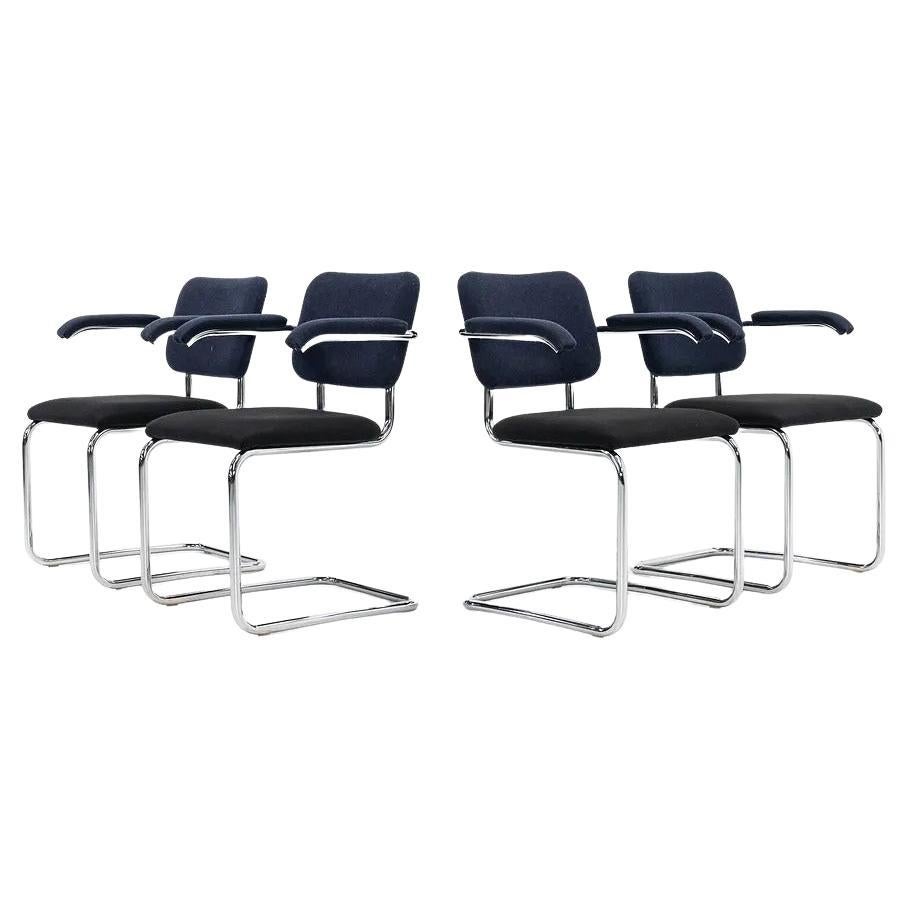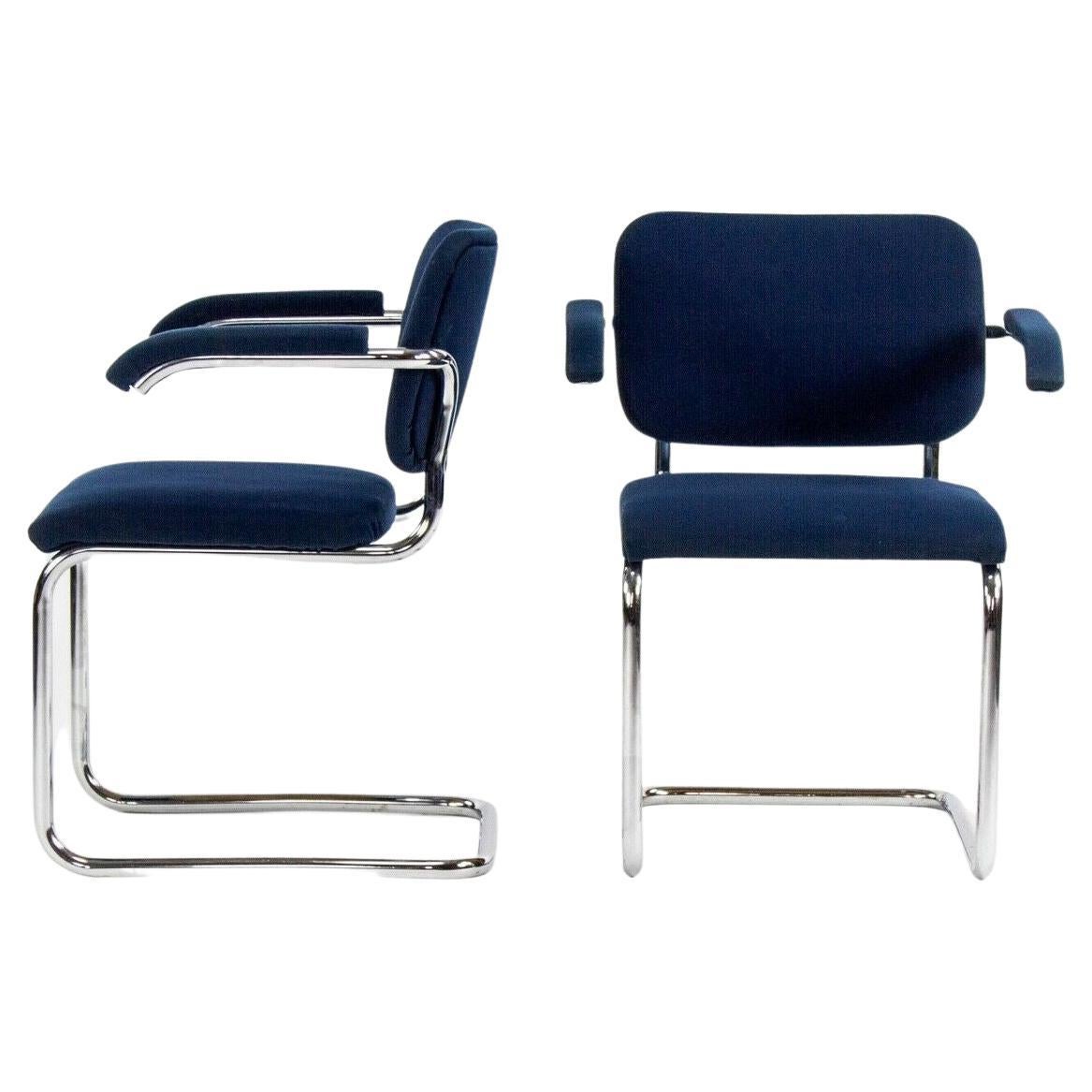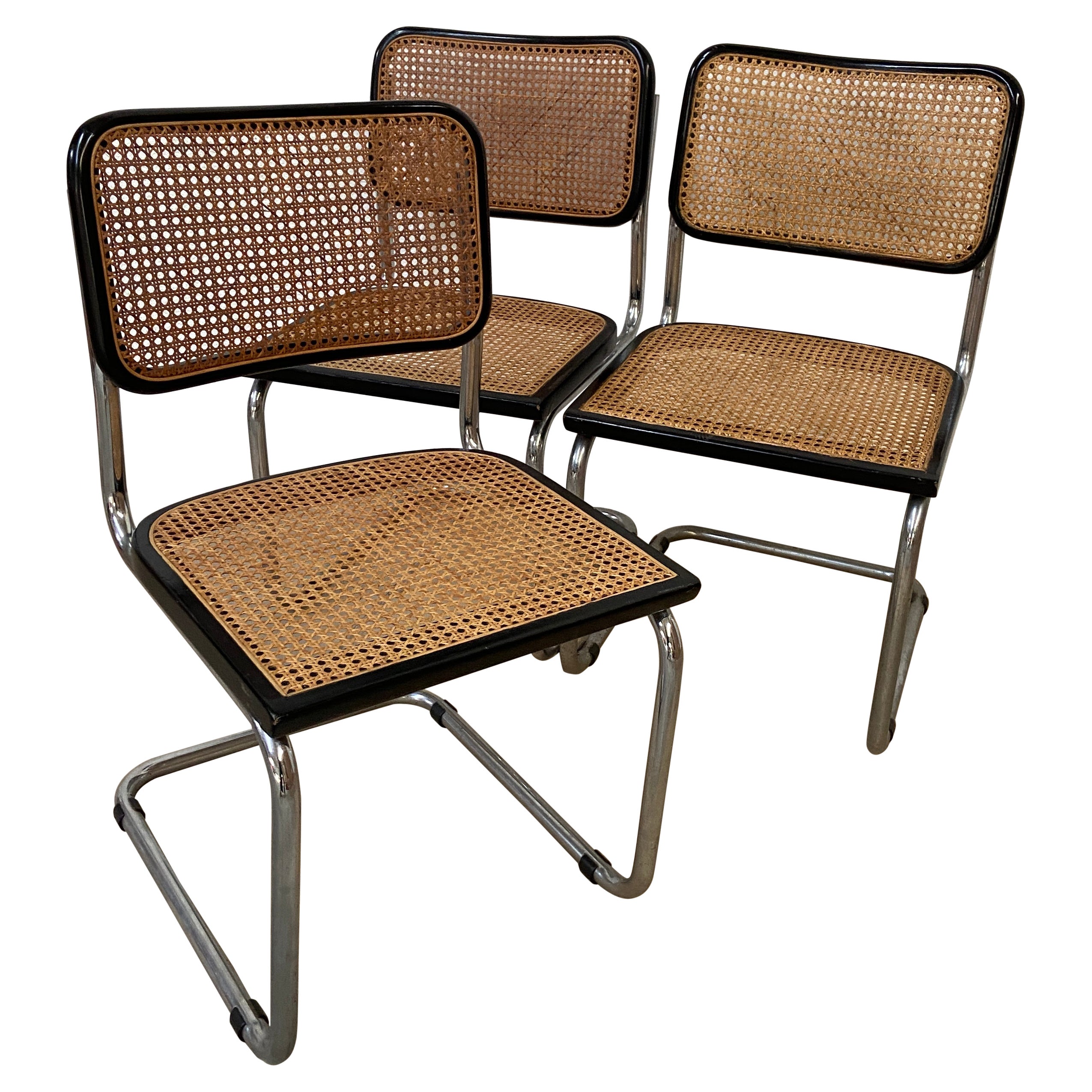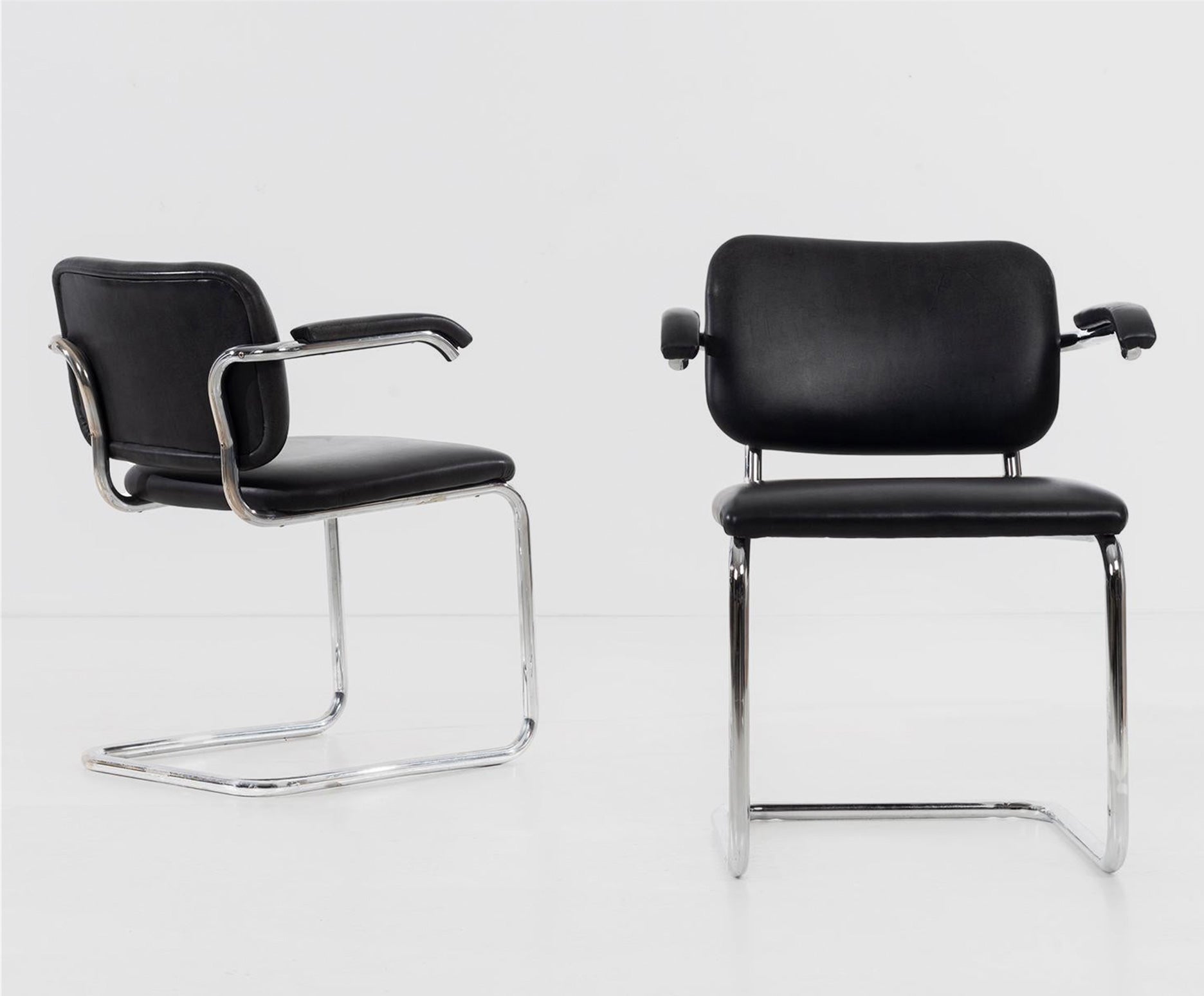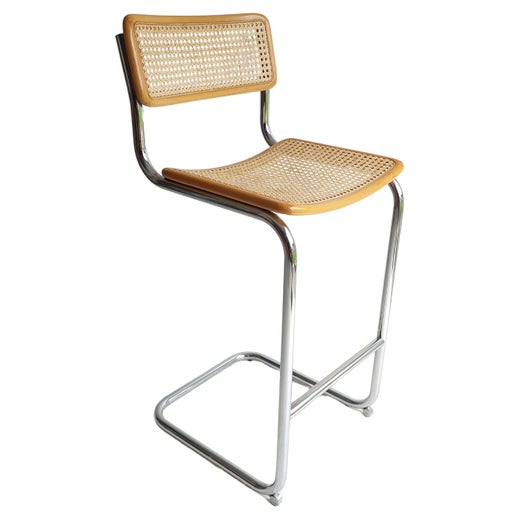Mid Century Modern Cesca Chair by Marcel Breuer for Knoll
About the Item
- Creator:Marcel Breuer (Designer),Knoll (Manufacturer)
- Design:
- Dimensions:Height: 32.68 in (83 cm)Width: 18.12 in (46 cm)Depth: 19.69 in (50 cm)Seat Height: 17.72 in (45 cm)
- Sold As:Set of 22
- Style:Mid-Century Modern (Of the Period)
- Materials and Techniques:
- Place of Origin:
- Period:
- Date of Manufacture:1990
- Condition:Refinished. Wear consistent with age and use.
- Seller Location:Lisboa, PT
- Reference Number:
Cesca Chair
Ubiquitous but never boring, the Cesca chair has defined casual elegance in the dining room since 1928. Designed by Marcel Breuer (1902–81) for the Austrian furniture maker Gebrüder Thonet, the original Cesca chair combines natural beechwood caning and modern tubular steel for a sensibility that celebrates both handicraft and industrialization. It’s a paragon of Bauhaus design, embodying the school’s “truth to materials” philosophy and adhering to the movement’s emphasis on mass production. In fact, the Cesca chair was the first-ever tubular steel frame chair with a caned seat to be mass produced — a breakthrough for furniture design.
Breuer got his start in architecture after dropping out of the painting program at the Academy of Fine Arts in Vienna. He began apprenticing with a Viennese architect and went on to join the Bauhaus movement in 1921, when he was just 19 years old, eventually becoming a master carpenter at the German arts school. While there, Breuer designed furniture for Sommerfeld House in Berlin, industrialist Adolf Sommerfeld’s private residence, which was conceived by architects Walter Gropius (the Bauhaus school’s founder) and Adolf Meyer. Not long afterward, Breuer’s experiments with tubular steel would yield his Wassily chair, named for his friend, painter and Bauhaus professor Wassily Kandinsky, as well as the Cesca.
Originally called the B32, Breuer renamed the chair in honor of his daughter, Francesca, when Italian manufacturer Gavina began producing it in the early 1960s. Knoll introduced the chair when it acquired Gavina in 1968 and continues to manufacture it today.
And while the Cesca chair’s silhouette has remained the same throughout the decades, Breuer himself later made minor modifications, including the implementation of a shallower curve to the back and the addition of a second piece of steel for the frame to account for both comfort and durability. With the Cesca’s cantilevered construction, Breuer’s design transcended that of the traditional four-legged dining chair, pushing the boundaries of what “everyday” could mean in furniture.
Marcel Breuer
The architect and designer Marcel Breuer was one the 20th century’s most influential and innovative adherents of modernism. A member of the Bauhaus faculty, Breuer — like such colleagues as the architects Walter Gropius and Ludwig Mies van der Rohe, and the artists and art theoreticians László Moholy-Nagy and Josef Albers — left Europe in the 1930s to champion the new design philosophy and its practice in the United States.
Born in Hungary, Breuer became a Bauhaus student in 1920 and quickly impressed Gropius, the German school’s founder, with his aptitude for furniture design. His early work was influenced by the minimalist Dutch design movement De Stijl — in particular the work of architect Gerrit Rietveld. In 1925, while he was head of the Bauhaus furniture workshop, Breuer realized his signature innovation: the use of lightweight tubular-steel frames for chairs, tables and sofas — a technique soon adopted by Mies and others. Breuer’s attention gradually shifted from design to architecture, and, at the urging of Gropius, he joined his mentor in 1937 on the faculty of Harvard and in an architectural practice.
In the 1940s, Breuer opened his own architectural office, and there his style evolved from geometric, glass-walled structures toward a kind of hybrid architecture — seen in numerous Breuer houses in New England — that pairs bases of local fieldstone with sleek, wood-framed modernist upper floors. In his later, larger commissions, Breuer worked chiefly with reinforced concrete and stone, as seen in his best-known design, the brutalist inverted ziggurat built in New York in 1966 as the home of the Whitney Museum of American Art.
Breuer’s most famous furniture pieces are those made of tubular steel, which include the Wassily chair — named after Wassily Kandinsky and recognizable for its leather-strap seating supports — and the caned Cesca chair. Breuer also made several notable designs in molded plywood, including a chaise and nesting table for the British firm Isokon and a student furniture suite commissioned in 1938 for a dormitory at Bryn Mawr College. Whether in metal or wood, Breuer’s design objects are elegant and adaptable examples of classic modernist design — useful and appropriate in any environment.
Find vintage Marcel Breuer seating, storage cabinets and lighting on 1stDibs.
- ShippingRetrieving quote...Ships From: Santarém, Portugal
- Return PolicyA return for this item may be initiated within 14 days of delivery.
- Mid Century Modern Rosewood Dining Chairs by Soren Willadsem for Vejen, 1960SBy Vejen Polstermøbelfabrik, Soren Willadsen MobelfabrikLocated in Lisboa, LisboaThis set of six dining chairs from the 1960s, designed by Søren Willadsen, exhibits the finesse of Danish craftsmanship and design ethos from the mid-20th century. The rosewood const...Category
Vintage 1960s Danish Mid-Century Modern Dining Room Chairs
MaterialsRosewood, Papercord
- Mid-Century Rosewood Dinning Chairs by Vestervig Erikson for Brdr. TromborgBy Vestervig Erikson, Brøderna TromborgLocated in Lisboa, LisboaThis midcentury set of six dining chairs, designed by Vestervig Erikson for Brdr Tromborg Lystrup, is a quintessential example of 1960s Danish furniture design. Crafted from rosewood...Category
Vintage 1960s Danish Mid-Century Modern Dining Room Chairs
MaterialsFabric, Rosewood
- Mid-Century Modern Rosewood Dining Chairs Made by Soro Stolefabrik, set of sixLocated in Lisboa, LisboaMid Century set of six elegant dining chairs, including two with armrests, crafted from rosewood and marked by Soro Stolefabrik—a Danish firm renowned for its collaboration with este...Category
Vintage 1960s Danish Mid-Century Modern Dining Room Chairs
MaterialsLeather, Rosewood
- Mid Century Set of 6 Rosewood H. P. Hansen Dining Chairs for RandersBy H.P. Hansen, Randers MøbelfabrikLocated in Lisboa, LisboaA wonderful set of 6 Danish rosewood dining chairs by HP Hansen for Randers Mobelfabrik, Denmark. Upholstered seats in papercord. These fantastic shaped Danish design chairs are made...Category
Vintage 1960s Danish Mid-Century Modern Dining Room Chairs
MaterialsRosewood, Papercord
- Mid Century Modern Set of 12 Rosewood Dining Chairs, 1960sLocated in Lisboa, LisboaThis exquisite set of 12 dining chairs by B.S. Møbler epitomizes the timeless elegance of mid-century design. Crafted from rich, warm rosewood, these chairs feature the sleek, clean ...Category
Vintage 1960s Danish Scandinavian Modern Dining Room Chairs
MaterialsRosewood, Fabric
- Mid Century Danish Dining Chairs by Skovby, 1950s, Set of 4By Skovby Møbelfabrik A/S 1Located in Lisboa, LisboaThis sleek set of four dining chairs has teak frames with ladder back rests and a padded seat. This wonderful Danish set of dining chairs e...Category
Vintage 1950s Danish Mid-Century Modern Dining Room Chairs
MaterialsWood
- Marcel Breuer for Knoll Cesca Side/Dining Chairs, 1980By Knoll, Marcel BreuerLocated in Chicago, ILMarcel Breuer for Knoll Cesca Side/Dining Chairs, 1980. Newly reupholstered green boucle. 6 of the green chairs have sold. We have a large quantity of these chairs. You are welcome t...Category
Vintage 1980s American Post-Modern Dining Room Chairs
MaterialsBouclé
- B32 Cesca Chairs by Marcel Breuer for GavinaBy Gavina, Marcel BreuerLocated in Chicago, ILc. 1960s. Price is for the set. Contact us if you’d like to purchase a single item. These Cesca chairs are an original example of the armless B32 chair by Marcel Breuer. They are ext...Category
Vintage 1960s Italian Mid-Century Modern Dining Room Chairs
MaterialsCane, Bentwood
- Set of Six Mid-century Italian Modern Marcel Breuer Cesca Chairs 70sBy Marcel BreuerLocated in Escalona, ToledoSet of six Cesca chairs, model B32, made in Italy in the 1970s. Some show signs of wear on the chrome but in general they are in good condition. Black lacquered beech wood frames an...Category
Antique Early 17th Century Italian Mid-Century Modern Dining Room Chairs
MaterialsSteel, Chrome
- 2018 Marcel Breuer for Knoll Cesca Armchair in Blue & Black Fabric, Model 50ABy Knoll, Marcel BreuerLocated in Philadelphia, PAThis is a Cesca armchair, model 50A, originally designed by Marcel Breuer in 1928. The listed price includes one 50A chair, and we have several available for individual purchase. The...Category
2010s American Modern Dining Room Chairs
MaterialsNickel, Steel
- 1970s Pair of Marcel Breuer for Knoll Cesca Upholstered Armchairs in Blue FabricBy Knoll, Marcel BreuerLocated in Philadelphia, PAListed for sale is a pair of 1970s vintage Cesca armchairs upholstered in blue fabric, produced by Knoll and designed by Marcel Breuer. The Cesca chair is an...Category
Vintage 1970s American Modern Dining Room Chairs
MaterialsMetal
- Mid-Century Modern Italian Set of Chrome and Black Cesca Chair by Marcel BreuerBy Marcel BreuerLocated in Prato, ITMid-Century Modern Italian set of 3 chrome cantilever Cesca chair with black lacquered wood profiles by Marcel Breuer. The chairs are in really good ...Category
Vintage 1970s Italian Mid-Century Modern Chairs
MaterialsChrome



